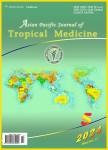Etiologies of tropical acute febrile illness in West Pahang, Malaysia: A prospective observational study
Etiologies of tropical acute febrile illness in West Pahang, Malaysia: A prospective observational study作者机构:Department of Medicine Hospital BentongBentongPahangMalaysia Institute for Public HealthNational Institute of HealthMalaysiaMinistry of Health MalaysiaSelangorMalaysia Department of Medicine Hospital Sultan Haji Ahmad ShahTemerlohPahangMalaysia Department of Pathology Hospital Sultan Haji Ahmad ShahTemerlohPahangMalaysia Department of Medicine Hospital Kuala LipisKuala LipisPahangMalaysia
出 版 物:《Asian Pacific Journal of Tropical Medicine》 (亚太热带医药杂志(英文版))
年 卷 期:2020年第13卷第3期
页 面:115-122页
核心收录:
学科分类:1004[医学-公共卫生与预防医学(可授医学、理学学位)] 100401[医学-流行病与卫生统计学] 10[医学]
基 金:We would like to thank the Director General of Health Malaysia for his permission to publish this article. We would express our gratitude to Dr Kamariah Ghazali, the director of Bentong Hospital, Dr Bahari Che Awang Ngah, the director of Sultan Haji Ahmad Shah, and the other respective hospital dire Mr. Mohd Hazrin B. Hashim, GIS specialist from the Institute for Public Health, Malaysia for supplying the spatial map of study locations and the director of Institute for Public Health, National Institute of Health Malaysia, Ministry of Health Malaysia
主 题:Comorbidities Mortality Tropical acute febrile illness
摘 要:Objective: To determine the etiologies of tropical acute febrile illness(TAFI) in West Pahang, Malaysia and to investigate morbidity and mortality factors in relation to TAFI. Methods: A multicenter prospective cohort study was conducted between January and June 2016 in six district hospitals throughout the western part of Pahang State in Peninsular Malaysia. A total of 336 patients answered a standardized questionnaire and blood samples were collected for laboratory confirmation of infectious etiology. Descriptive analysis and logistic regression were performed to identify factors associated with TAFI. Results: A total of 336 patients were included. The patients were mainly Malays(70.2%), males(61.3%), aged(44.6±17.4) years, with more than half(58.9%) presenting with gastrointestinal symptoms. The majority were diagnosed with dengue(35.7%) while malaria(4.5%) was the least frequent. The in-hospital mortality due to TAFI was 9.2%. Patients with meliodosis had five times higher mortality [Adjusted OR: 5.002, 95% CI:(1.233, 20.286)]. Patients with comorbidities such as cardiovascular symptoms(P0.001) and renal replacement therapy initiation(P0.001) were significantly associated with in-hospital mortality in all TAFI. Conclusions: The etiology of TAFI in the western Pahang includes dengue, leptospirosis, malaria and melioidosis, which carry the highest risk of in-hospital mortality. The presence of cardiovascular symptoms may be used to assess the disease severity in TAFI, but more studies are needed in the future.



